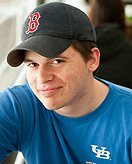News
UB student donates bone marrow
-
 Print
Print -
 Comments
(1)
Comments
(1)
-

On a whim, UB student Alex Teschemacher signed up with a bone marrow registry. Now, he may be saving a life. Photo: DOUGLAS LEVERE
Like most people who don’t personally know someone who needs a transplant, UB student Alex Teschemacher hadn’t considered becoming a bone marrow donor. But in the fall of 2009, while walking through the Student Union, he and a friend came upon a National Marrow Donor Program recruitment drive sponsored by the UB Prehealth Advising office. On the spur of the moment, they decided to register.
“When I signed up, it was pretty much to impress the girl I was with,” Teschemacher recalls, smiling. “We signed up to be on the registry and they took a cheek swab to get DNA. A year later, I was on the operating table.”
In an outpatient procedure that Teschemacher underwent last month at Roswell Park Cancer Institute, a needle was used to extract bone marrow from the back of his pelvic bone; the marrow replaces itself completely within several weeks.
Despite some local bruising and soreness, the UB sophomore and Acker Scholar was back at school about two weeks later, catching up on coursework for his history/political science double major and preparing for UB’s Relay for Life American Cancer Society fundraiser.
The National Marrow Donor Program (NMDP) is a nonprofit organization dedicated to creating opportunities for patients to receive transplants of peripheral blood stem cells, bone marrow or umbilical cord blood when they need it. Seventy percent of patients who need such transplants rely on the program and its “Be the Match Registry” to potentially save their lives because they do not have a donor match in their own families.
Teschemacher wasn’t expecting to be a match.
“It was like winning the lottery, a crazy long shot,” he recalls. “I signed up, thought about it for two minutes and didn’t give it a second thought until I got the email in December.”
That email informed Teschemacher that he was one of just 12 people on the registry who were possible matches for a patient who needed a transplant.
“My odds had gone from being something like one in over 500 to one in 12,” he says. “I was kind of stunned. But, because I’m a numbers guy, I thought I’d have an 8 percent chance.”
Shortly after he had the required blood test, Teschemacher received the call at work: He was the best match.
“I had until 10 days before the procedure to back out,” he says. “But even when I got the email, I knew I would do it. It would be really hard to justify saying no. It didn’t cross my mind.”
The type of procedure that Teschemacher underwent occurs in 18 percent of transplants, according to the NMDP, while about 60 percent involve peripheral blood stem cells, in which the donor takes a drug to boost blood-forming cells in the bloodstream; the blood is subsequently donated at a blood center or outpatient hospital unit.
The NMDP estimates that the risk to donors who undergo either procedure is less than 2 percent.
Like all donors, Teschemacher knows just a few key facts about the patient whose life he may be saving: It is a woman, she is 60 years old and she has a condition that is a precursor to leukemia.
“With life expectancy for women around 77, this could add 17 years to her life,” he says. “Without it, the disease would turn into full-blown leukemia in two years and she could be dead in five.”
About four to six weeks after the transplant of his bone marrow into the patient, Teschemacher will be informed as to whether or not the transplant was successful. If it has been successful, it is the patient’s prerogative to contact the donor after a year has passed.
Teschemacher says he hopes his story will encourage others to sign up to be donors as well. “I think every eligible person should at least be on the registry,” he says. “Odds are exceedingly long that you’ll be called, but being on the list is also a great feeling.”
And he is still surprised by the reaction he gets when people find out he is a bone marrow donor.
“I was told, we want you to have minor surgery,” he says. “You’ll be fine in a month and you can add years to this person’s life. There is a certain amount of pain involved, but that shouldn’t act as a deterrent. It is absolutely worth the shot at saving someone’s life.”

Reader Comments
Kate Rittenhouse-Olson says:
Congratulations Alex! You became a hero on that whim! Not everyone gets a chance to save a life and you not only did that but your attitude and story may encourage others to register as well.
Posted by Kate Rittenhouse-Olson, Professor, 04/04/11